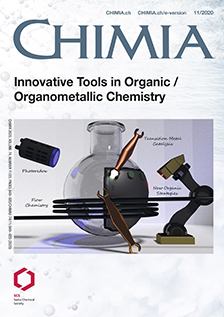Towards Atropoenantiopure N–C Axially Chiral Compounds via Stereoselective C–N Bond Formation
DOI:
https://doi.org/10.2533/chimia.2020.883PMID:
33243324Keywords:
Asymmetric synthesis, Axial chirality, Hypervalent iodine, C–n axial chirality, N–c atropisomerism, N–c axial chiralityAbstract
N–C axial chirality, although disregarded for decades, is an interesting type of chirality with appealing applications in medicinal chemistry and agrochemistry. However, atroposelective synthesis of optically pure compounds is extremely challenging and only a limited number of synthetic routes have been designed. In particular, asymmetric N-arylation reactions allowing atroposelective N–C bond forming events remain scarce, although great advances have been achieved recently. In this minireview we summarize the synthetic approaches towards synthesis of N–C axially chiral compounds via stereocontrolled N–C bond forming events. Both organo-catalyzed and metal-catalyzed transformations are described, thus illustrating the diversity and specificity of both strategies.Downloads
Published
2020-11-25
Issue
Section
Scientific Articles
License
Copyright (c) 2020 Johanna Frey, Sabine Choppin, Françoise Colobert, Joanna Wencel-Delord

This work is licensed under a Creative Commons Attribution-NonCommercial 4.0 International License.
How to Cite
[1]
J. Frey, S. Choppin, F. Colobert, J. Wencel-Delord, Chimia 2020, 74, 883, DOI: 10.2533/chimia.2020.883.







